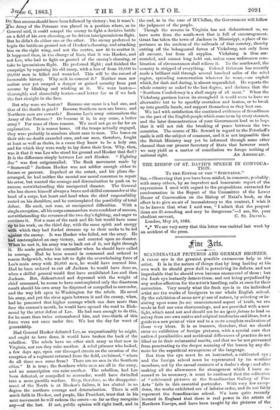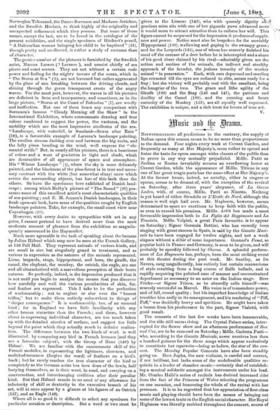lute Arts.
SCANDINAVIAN PICTURES AND GERMAN BRONZES.
A FRESH eye is the greatest possible extraneous help to the artist. It is in the nature of things that by long looking at his
own work he should grow dull in perceiving its defects, and not improbable that he should even become enamoured of them ; but the fresh eye instantly detects them, and not being prejudiced by any undue affection for the artist's bantling, calls at once for their correction. Very nearly what the fresh eye is to the individual artist are the works of foreigners to our whole English school. By the exhibition of some new phase of nature, by selecting or in- sisting upon some (to us) unaccustomed aspect of truth, we arc made to feel our own shortcomings, and are provided with a new light, which need not and should not be an ignis fatuus to lead us astray from our own native and original tendencies and ideas, but a guide to a new point of view and to a more complete realization of those very ideas. It is as learners, therefore, that we should enter an exhibition of foreign pictures, with a special care that national peculiarities and accidental differences of practice do not blind us to their substantial merits, and that we be not prevented from penetrating to the deeper meaning of the lesson by any dis- taste for the superficial strangeness of the language.
But then the eye must be an instructed, a cultivated eye ; and the foreign school must be represented by its worthier members, not by the casual contents of a dealer's shop ; and after making all the allowances for strangeness which I have as- sumed to be necessary, it must be confessed that the collection of "celebrated pictures at the Scandinavian Gallery of Fine Arts" fails in this essential particular. With very few excep- tions, the works exhibited are of inferior order, and do not fairly represent the Scandinavian school. We have quite recently learned in England that there is real power in the artists of Northern Europe, and have been taught by the pictures of the
Norwegian Tidemand, the Danes Sorensen and Madame Jerichau, and the Swedish Hiickert, to think highly of the originality and unexpected refinement which they possess. But none of these names, except the last, are to be found in the catalogue of the present exhibition, and the single 'specimen of Hockert's pencil, "A Dalecarlian woman bringing her child to be baptized" (21), though pretty and unaffected, is rather a study of costume than of character.
The greater number of the pictures is furnished by the Swedish artist, Marcus Larson (? Larsson ), and consist chiefly of sea pieces and coast scenes. They are not without a certain rude power and feeling for the mighty terrors of the ocean, which in "The Storm at Sea" (3), are not lessened but rather aggravated by the glare of sun breaking between the driving clouds, and shining through the green transparent crests of the angry waves. For the most part, however, the waves in all his pictures are deficient in form and transparency, and sometimes, as in the large picture, "Storm at the Coast of tohuslan " (1), are woolly and ineffective. Not one of them bears any comparison with Sorensen's famous "Cloudy Morning off the Skew" in the International Exhibition, where consummate drawing and true colour combined to suggest the power, the vastness, and the mobility which are the most impressive attributes of the sea.
"Landscape, with waterfall, in Smaland—Storm after Rain " (10), is a favourable example of Larsson's landscape painting.
The swollen stream dashing over and between the big rocks, and the lofty pines bending to the wind, well express the " ele- mental strife." But, in nearly all his pictures, there is a heaviness of colour and a want of gradation in light and shade, which are destructive of all appearance of space and atmosphere. His "Winter Landscape" (4), where the sky is more delicately painted, and the blackness of the pine-forest is in true and neces- sary contrast with the white (but somewhat slimy) snow which covers the surrounding objects, has less of this fault than the others. So have the specimens here exhibited of Danish land- scape; among which Melby's picture of "The Sound" (26) pos- sesses some of this excellent artist's most characteristic qualities of sea-painting ; and E. M. jensen's Danish landscapes, in their fresh open-air look, have more of the qualities sought by English landscape painters. Take, for example, the small coast view near Copenhagen (28).
However, with every desire to sympathize with art in any guise, I cannot pretend to have derived more than the most moderate amount of pleasure from the exhibition so magnilo- quently announced in the Haymarket.
Much more agreeable is the task of speaking about the bronzes by Julius Hiihnel which may now be seen at the French Gallery, at 120 Pall Mall. They represent animals of various kinds, and are small in size but singularly grand in treatment, and as various in expression as the natures of the animals represented.
Lions, leopards, stags, hippopotami, and hens, the giraffe, the camel, the elephant, the monkey, the ostrich, the eagle, are one and all characterized with a marvellous perception of their brute natures. So perfectly, indeed, is the impression produced that it is not until you begin to analyse the means that you discover how carefully and well the various peculiarities of skin, fur, and feather are expressed. This I take to be the perfection of workmanship ; not to neglect or slur over the "honest trifles," but to make them entirely subservient to things of "deeper consequence." It is workmanship, too, of an unusual kind ; for in England we have little familiarity with any other bronze statuettes than the French ; and these, however clever in expressing individual character, are too much taken lip with the detailed niceties of surface, and suggest too little beyond the point which they actually reach in definite realiza- tion. The difference between the two kinds of work is well illustrated, by comparing any bird in French bronzes (and they are a favourite subject), with the Group of Hens 0.49) by Hahne'. We are familiar with the consummate skill of the French modeller, in representing the lightness, closeness, and multitudinousness (forgive the word) of feathers on a bird's back ; but he rarely reaches the true character of the bird so completely as the German artist has here done of the fowls, half burying themselves, as is their wont, in sand, and carrying on a conversation, and interchanging civilities after their peculiar kind. But that Htihnel stands in no need of any allowance for inferiority of skill or dexterity in the executive branch of his art, will at once appear by a glance at his figures of an Ostrich (137), and an Eagle (148).
Where all is so good it is difficult to select any specimen for particular mention or description. But a word or two inust be
given to the Lioness (142), who with queenly dignity at gracious mien sits with one of her gigantic paws advanced more it would seem to attract attention than to enforce her will. This %" figure cannot be surpassed for the impression it produces of supple- ness and power. Notice must also be bespoken for the unwieldy Hippopotami (150), wallowing and gaping in the swampy grass ; and for the Leopards (145), one of whom has scarcely finished his meal off the carcase of a deer before he is interrupted and a share of his good cheer claimed by his rival—admirably given are the action and motion of the animals, the indirect and stealthy approach of the invader, the jealous tenacity of the weaker animal "in possession." Each, with ears depressed and snarling lips retracted till the eyes are reduced to slits, seems ready for a fray ; but the victory will probably rest with the assailant, being the hungrier of the two. The grace and lithe agility of the Giraffe (139) and the Stag (146 and 147), the patience and docility of the Camel (138), and the cunning and brute curiosity of the Monkey (161), are all equally well expressed. The exhibition is unique, and a rich treat for lovers of true art.
V.































 Previous page
Previous page